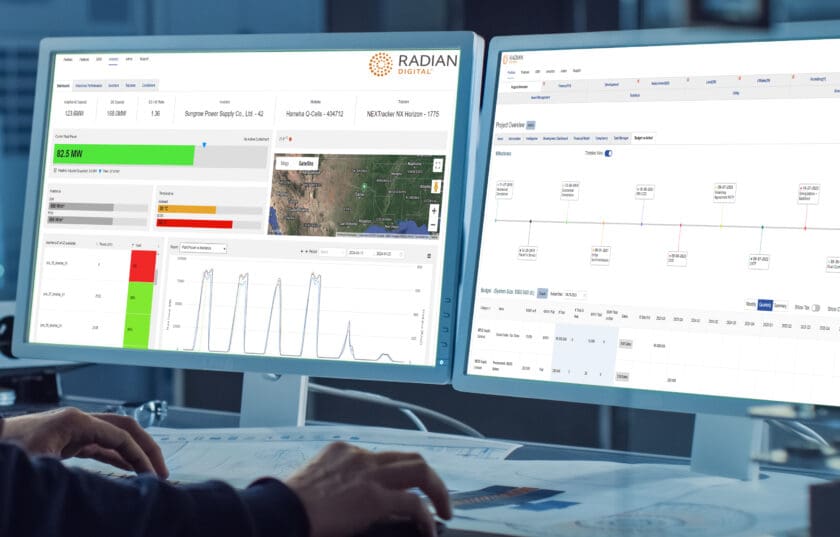We are standing at the brink of a digital revolution in the renewable energy industry, and it is not just a technological shift – it is a game changer for efficiency and accuracy. Digitization is a necessity for organizations to thrive in this rapidly growing and changing landscape. Technological innovations are constantly improving the efficiency of renewable energy production and storage while modern software solutions are increasing the breadth of diagnostic and performance data available. Technological advancements also mean a dizzying pace of changes in the regulatory and compliance landscape designed to ensure grid efficiency and resilience. Consequently, the potential for digitization extends beyond streamlined operations and compliance; it holds the possibility of significantly boosting profitability and empowering the industry to deliver on its promise of renewable energy for a better tomorrow.
The integration of multiple applications for managing energy production, grid operations, regulatory compliance, and financial performance is inherently complex. It requires a platform designed specifically for the renewable energy sector that addresses overarching needs, enables simple data aggregation (pulling data from multiple sources), simplifies communication, and facilitates data exchange with core business systems between various departments of the business. While navigating the complexities of this digital transformation can be challenging, partnering with a specialized renewable energy software provider can help guide you through the lifecycle of your projects.
Most technology platforms are built to scale with you, so regardless of the problem you need to fix now or where to start with digitization, you have the flexibility to open more functionality as your business needs and challenges evolve. Regardless of what stage a renewable energy facility is at, most technology solutions provide tools that optimize project development, streamline operations to improve performance, and mitigate risks.
Optimize Project Development
Ensuring renewable energy projects are delivered on time and within budget is simply not practical nor achievable without digital solutions. Managing renewable energy projects includes all the details related to power sales, permitting, interconnection, and land control. It starts with project development tools that track progress, manage budgets, generate financial models, and maintain stakeholder relations. Land control for renewables can be complex, having a digital solution that centralizes data such as stakeholder agreements, ownership, and utilization of rights should provide tools to automate tasks such as landowner payments, accounts payable and property tax calculations, and streamlining projects. These digital solutions are designed to harvest critical data and can deliver on-demand insightful reports. It may also include a Gantt interface to stay on schedule, manage resources, track budget vs actuals, and improve visibility with earlier identification of risk.
 Streamline Operations to Improve Performance
Streamline Operations to Improve Performance
A modern technology platform is designed to streamline operations and maximize the value of your operating portfolio with in-depth, impactful analytics, configurable KPIs, and timely accurate reporting. Automated tools for field operations ensure operations and maintenance (O&M) activities are optimally managed to drive project profitability through prioritized management of issues that have the biggest revenue impact.
Dashboards are usually configurable and can help visually communicate a snapshot of portfolio performance, automate monthly operating reports, and provide a forward-looking technical perspective on future financial results to operators, managers, and investors.
Streamlining data acquisition from multiple sources into one central location provides a shared workspace for collaboration across departments. This can transform the management of agreements, streamline compliance, and provide seamless accounting integration. As everything is digital, there is always an auditable workflow.
Risk Mitigation
These tools are designed to identify risks and provide alerts and procedures to address these risks and in doing so, manage resources accordingly. It includes tools for compliance with the automation of sorting and flagging of issues for escalation to ensure regulatory requirements are met.
Effective internal controls support the security and reliability of the Bulk Electric System (BES) by identifying, analyzing, and fixing issues. Using internal digital controls can help owners and operators maintain compliance with North American Electric Reliability Corporation (NERC Reliability Standards). NERC considers internal controls to be a critical component of a strong compliance program and includes, risk assessment, design, control implementation, activity monitoring, and evaluation.
Risk mitigation also entails managing contractual obligations such as monthly operating reports and quarterly financials. Keeping certificates of insurance up to date and streamlining data-intensive tax management activities are all part of a comprehensive digital risk mitigation toolset.
Must Haves in a Technology Platform
- Seamless integration using robust APIs for data acquisition from SCADA providers, virtual weather service providers, and other software programs including enterprise resource planning (ERP) and file-sharing systems.
- Cloud hosting capabilities can provide many advantages including, remote access, hands-off upgrades to the software, right-sized controls, and recurring audits to ensure maximum uptime.
- Configuration is key as every renewable energy facility is unique so having a technology platform that can adapt and display your workflows is critical. Customizing user interfaces, or dashboards allows users to see a scenario snapshot, for example, actual vs optimal performance, resource availability, and missed compliance activities.
- Partnering with a solution provider that has ongoing customer support to help onboard new users, problem solve, adapt to changes in technology and the ongoing changes in regulations can significantly impact the success of your technology platform. Find a company with real accessible people.
- Stringent security, ensure technology suppliers have ISO 27001 certification and implement measures to defend against potential threats and align with regulatory standards for secure and sustainable energy production.
- Scalability enables any type of renewable energy provider with a problem that needs solving to start today. Adding on functionality as needed helps with budgeting, and better results make it is easier to justify adding more functionality to streamline more processes.
In Conclusion
Capabilities across the lifecycle of renewable energy that address project development optimization, streamlined operations performance, and risk management are at the heart of a modern digital platform. Giving renewable stakeholders access to real time operational information from one source gives them the ability to make data driven decisions, regardless of where they are. Organizations that use data rooms and spreadsheets are missing the potential to bring renewables to the forefront of power generation – the change is easier than you think.






